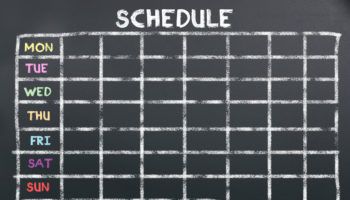Lisa Mulliken
Piaget is a well-known name in the early childhood world. Piaget was a Swiss psychologist who created theories of cognitive development. Piaget’s theories included the concept of schemas. In simple terms, a play schema can be thought of as a group of instructions or repeated behaviors that children use during play. Children use schemas to understand the world and, once mastered, children can apply the knowledge to a new situation or make predictions about things. Some common schemas observed in young children include:
Trajectory
This is one of the earliest schemas and the one that is most often considered as an inappropriate behavior. Children exploring this schema are investigating how their bodies or other objects move from one place to another. Think about the baby that repeatedly drops food or toys from their highchair or the toddler that is constantly throwing toys. Toys and activities that can support children exploring this schema include balls, beanbags, catching and chasing bubbles, flying kites and using vehicles with ramps.
Transporting
Have you ever noticed that the purses in your dramatic play area are often filled with an assortment of random objects? Do you have a child who always puts toys or rocks in their pocket? Or a child who is fascinated with construction vehicles? Children exploring this schema like to carry things from one place to another. Toys and activities to support this schema include grocery carts, baby strollers, buckets and baskets for children to fill, empty and transport.
Enclosing
My granddaughter explored this schema by repeatedly using her blocks or Magna Tiles to create enclosures for her animals. From cages in a zoo, rooms in a house or fences for a barn, she worked hard on creating these boundaries which would stay untouched in my house until her next visit. Children exploring this schema may also enjoy making tents and forts, playing in empty boxes, using nesting toys and making circles around other objects while drawing or painting.
Connecting
This schema also includes disconnecting. Children exploring this schema like to put things together and take them apart. You may notice the child who loves to repeatedly create block towers and knock them down. This is one reason that Legos and Magna Tiles are so popular with young children. And why young children have such a fascination for using tape and glue. Fine motor materials are great for encouraging the connecting schema.
Teachers who notice and support children’s schema play are encouraging children’s cognitive development. Play schemas provide opportunities for children to use higher order thinking skills, such as predicting, brainstorming and problem solving and help children to integrate concepts and relate experiences to their own lives. When teachers understand that a child who loves to climb and jump off everything may be exploring a trajectory schema, they can provide appropriate activities to help the child continue their exploration. So, remember, the child who is constantly throwing toys may someday be a major league pitcher or a mechanical engineer who designs roller coasters!




